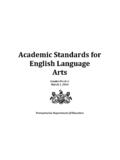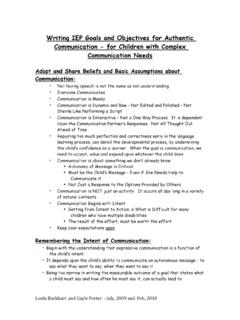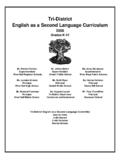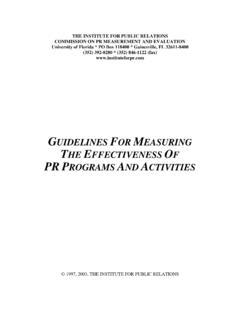Transcription of Content and Language Objectives - Jones & Bartlett Learning
1 65 Are you fit company for the teacher you wish to become? Author unknown If a child can t learn the way we teach, maybe we should teach the way they learn. IgnacioEstradaReaders will be able to:1. Describe why it is important to develop learner objectives2. Define and give examples of health education Content objectives3. Explain how standards are used to develop Content objectives4. Define and give examples of health education Language objectives5. Differentiate between Content Objectives and Language objectives6. Develop clear and concise Content Objectives and Language objectives7. Modify Content Objectives and Language objectivesIntroductionTravelers need maps and other tools to help direct and guide them to theirdestinations. Land travelers may need road maps and landmarks to assistthem.
2 Water travelers may need a compass and navigational maps to find thesafest path to their destination. Using these tools increases the likelihoodthat travelers will arrive at their predetermined destination. In recent years,the increased use of Global Positioning Systems (GPS) has allowed travelersto more easily find their destinations. Likewise, teachers can use informationand tools to help direct and guide them in providing the most appropriatelearning experiences for their who can clearly define the lesson s learner Objectives are wellunder way to providing their students with appropriate teaching strategiesOBJECTIVESC ontent and 5/15/09 4:38 PM Page 65 Jones and Bartlett Publishers, LLC. NOT FOR SALE OR DISTRIBUTION.
3 And student Learning activities. Knowing where you, as the teacher, want thestudents to end up is a critical step in the educational process. In addition,students who have the opportunity to see (in written form) and hear (orally)their Learning Objectives prior to instruction are more likely to achieve thelearner Objectives than students who do not have those opportunities to seeand hear their Learning Objectives . Stated another way, students who knowwhat Learning is expected of them, prior to instruction, are more likely toachieve their learner Objectives . In addition, prior to instruction, studentsshould also have the opportunity to ask clarifying questions about theirlearner objective(s).The focus of this chapter is on learner Objectives .
4 Learner objectivesdiffer from teacher Objectives . Learner Objectives are intended to clearly define what the studentisexpected to know and/or be able to do as a result of the instruction. Teacher Objectives typically indicate what the teacherwill do in providingthe instruction, such as explain an assignment, show a video, assign stu-dent work groups, or monitor student Language diverse classrooms, there are two important and distinct learnerobjectives: 1. Content Objectives 2. Language objectivesAs mentioned previously, learner Objectives Content and/or Language should be given to students every day using two important techniques: (1)Students should see(in written form) and hear(orally) their Content and/orlanguage Objectives priorto instruction and (2) have the opportunity to askclarifying questions about their Learning objectivesdefine the essential intended knowledge of the disci-pline (Rohwer & Wandberg, 2005).
5 These are typically characterized byfacts, concepts, and/or skills. Content Objectives are generated and derivedfrom several sources. Most commonly, in school health education, thesesources include the National Health Education Standards, state healtheducation standards or guidelines, local school district health educationstandards or guidelines, and in some instances, teacher standards school health education, the National Health Education Standards(Joint Committee on National Health Education Standards, 2007) and theirWhat Are ContentObjectives?66 Chapter 4 Content and Language 21/4/09 4:42 PM Page 66 Jones and Bartlett Publishers, LLC. NOT FOR SALE OR DISTRIBUTION. Question rationale and performance indicators (see Appendix) provide,from a national perspective, the school health education Content , most states rely on these national standards to provide the schoolhealth education framework at the state and district level.
6 The NationalHealth Education Standards form the basis from which specific contentobjectives can be Health Education StandardsThe eight standards are: Standard 1:Students will comprehend concepts related to health promo-tion and disease prevention to enhance health. Standard 2:Students will analyze the influence of family, peers, culture,media, technology, and other factors on health behaviors. Standard 3:Students will demonstrate the ability to access information,products, and services to enhance health. Standard 4:Students will demonstrate the ability to use interpersonalcommunication skills to enhance health and to avoid or reducehealth risks. Standard 5:Students will demonstrate the ability to use decision-makingskills to enhance health.
7 Standard 6:Students will demonstrate the ability to use goal-setting skillsto enhance health. Standard 7:Students will demonstrate the ability to practice health-enhancing behaviors and to avoid or reduce health risks. Standard 8:Students will demonstrate the ability to advocate for per-sonal, family, and community the Appendix for the rationale and performance indicators associatedwith each of the eight National Health Education StandardsIn addition to the National Health Education Standards, individual statesoften develop state health education standards or guidelines. Although moststates choose to base their state standards or guidelines on the national stan-dards, some states may elect to use, not use, adapt, revise, or modify theNational Health Education may choose to use the National Health Education Standards asstated and then add additional state-level health education states may place increased effort on specific health education stan-dards and lesser, or even none, on other health education standards.
8 Somestates may provide specific Content Objectives aligned with the state s spe-cific standards. Some states allow the individual school districts within 21/4/09 4:42 PM Page 67 Jones and Bartlett Publishers, LLC. NOT FOR SALE OR DISTRIBUTION. 68 Chapter 4 Content and Language Objectivesstate to develop their own unique health education standards and and School StandardsIn some states, schools/districts develop their own unique health educationstandards and Content Objectives at the local level. As with the state level,some schools/districts may wish to put additional effort in some areas ofhealth education and less or even none in other health education areas. Forexample, some states may wish to put a special health education emphasison water safety, frostbite prevention and care, hunting safety, nutrition, orHIV StandardsAnd finally, health education teachers may have the opportunity to addadditional standards and Content Objectives as they deem important andrelative.
9 Typically, teachers do not have the option to subtract from thedistrict school standards. One exception is where federal law permits aswith Individualized Education Programs (IEPs). The IEP documentsdescribe the student s special education and related services. It also describesthe current level of performance and the curriculum s long- and short-termgoals and education Content Objectives , at all levels, may be influenced byfederal, state, or local public or private health-related agencies and/or organiza-tions. Ideally, school health education programs should be part of a coordi-nated school health program (see Appendix).Based on the National Health Education Standards, a comprehensivehealth education program should provide a planned, sequential, K 12 cur-riculum that addresses the physical, mental, emotional, and social dimen-sions of health.
10 The curriculum is designed to motivate and assist studentsto maintain and improve their health, to prevent disease, and to reducehealth-related risk behaviors. It allows students to develop and demonstrateincreasingly sophisticated health-related knowledge, attitudes, skills, andpractices (Joint Committee on National Health Education Standards,2007). According to the CDC, the following are key elements of compre-hensive health education programs:1. A documented, planned, and sequential program of health instructionfor students in grades kindergarten through twelve2. A curriculum that addresses and integrates education about a range ofcategorical health problems and issues at developmentally appropriateages3. Activities that help young people develop the skills they need to avoidtobacco use; dietary patterns that contribute to disease; sedentarylifestyle; sexual behaviors that result in HIV infection, other STDs, 21/4/09 4:42 PM Page 68 Jones and Bartlett Publishers, LLC.

















